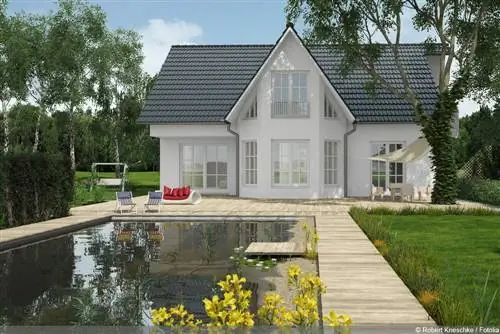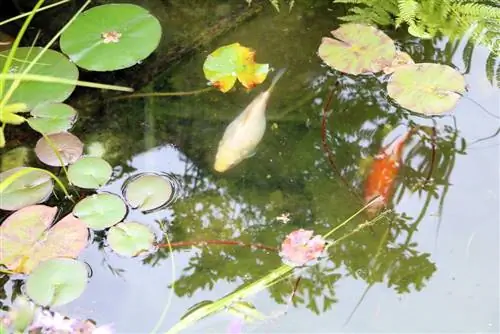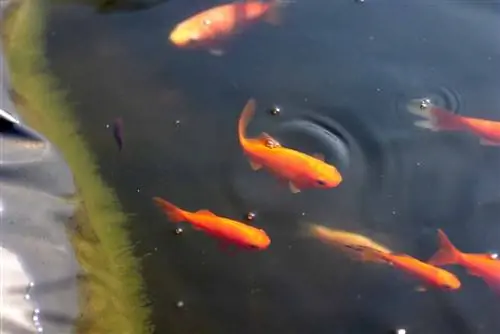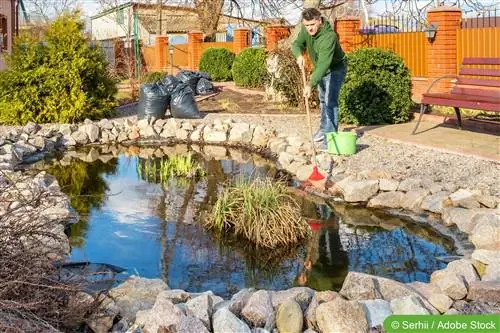- Author admin [email protected].
- Public 2023-12-17 03:39.
- Last modified 2025-06-01 06:48.
After Koi have a long tradition in Asia, they have been enjoying steadily growing popularity in this country in recent years. Unfortunately, pond owners do not give enough thought to the highly complex issue of keeping Koi species appropriately before purchasing, which usually has fatal consequences. Although koi are carp and are therefore very adaptable by nature, there are still countless things that need to be taken into account when keeping them if you want to enjoy these beautiful animals for as long as possible and with a clear conscience.
The Koi Pond
The koi pond should be in the shade if possible so that the water is not warmed up too much by direct sunlight. The problem is less the actual temperature, but rather the oxygen content of the water, which decreases as the water temperature increases. For this reason, the pond substrate should not be too dark in color so that sunlight is reflected rather than attracted. Regardless, you can see the koi better with such a surface. It would also be an advantage if the sun had the smallest possible “attack surface”. However, this does not mean that the pond as a whole can be small, as Koi continue to grow until the end of their life and can easily reach a length of one meter or more.
Therefore, each individual koi should have at least one cubic meter of water available. It is therefore advisable to build the koi pond in depth rather than in width and length. An average depth of a good two meters would be ideal, especially since pleasantly cool temperatures still prevail at the bottom of the pond even in unusually hot summers. In addition, due to the depth of the water, the bottom of the pond cannot freeze over in winter, so you don't necessarily have to move your koi to an aquarium in the house to survive. In addition, a pond heater, which is strongly recommended by many Koi keepers, is not an absolute must if there is sufficient water depth, at least in areas with temperate winters, although it can certainly provide a feeling of security.
Nevertheless, in winter you should always ensure that the pond surface does not freeze completely, otherwise the oxygen content in the water could become too low. Another argument in favor of an opening in the ice layer is that any gases that arise, for example, from the decomposition of organic substances can still escape from the pond. As a rule, it is usually enough to cover the pond with a tarpaulin to prevent the water surface from freezing over. You often hear that the use of circulation pumps can prevent the pond surface from freezing over. That's not wrong either. However, this would lead the water, which is very cold on the surface, down to the bottom of the pond, so that the Koi, which are actually safe, could freeze to death. In summer, however, it makes sense to use circulation pumps as they enrich the water with vital oxygen. If you don't want to rely on a tarpaulin alone, you can also use a float that slightly swirls the water on the surface. It is also important to ensure that the turbulence does not transport cold water to the ground.
What you should know about koi care in brief
The number of things that need to be taken into account when creating a suitable pond and maintaining it correctly can be daunting right away. Since the Nishikigoi, as the colorful carp were originally called, are incredibly beautiful and extremely fascinating animals, it is worth taking a closer look at the consistently interesting topic of keeping Koi species appropriately.
The word Nishikigoi comes from Japanese and means something like colorful carp, but the short form Koi has become established, although the beautiful fish are not really Japanese at all. Rather, their place of origin is assumed to be East Asia, the Black and Caspian Seas, the Aral Sea and China. But there are also traditions that assume the origin of the koi in Iran, from where it only later reached Asia.
Attitude / Care
- Species-appropriate foodstuffs are primarily fish nutrients living in the water as well as additional aquatic plants and algae.
- Since the amount of natural food in a conventional ornamental pond is far from enough, you have to add additional food.
- Koi are omnivores, but the type of food depends heavily on the water temperature.
- If it is low, the animals have a harder time digesting what they eat and should mainly get easily digestible carbohydrates.
- As the water temperature rises, it is important to gradually switch to a food with a higher fat and protein content.
- Food that is nutritionally balanced can be obtained from various providers on the Internet or from special breeders.
Koi dealers and breeders / Koi breeders
- Koi are fed sparingly at dealers so that they don't pollute the water so much.
- Koi lovers tend to spoil their pets too much because they are constantly begging for food.
- In the first 10-14 days, the koi freshly raised in the garden pond should only receive small portions of easily digestible wheat germ food.
The actual koi season only begins in spring, when temperatures are consistently above 16 °C. In winter, if you don't bring the animals into the house anyway, you should definitely think about heating the pond. The temperature should not fall below 4 °C, which can also be achieved with a suitable pond cover.
History of Koi
From 1800 onwards, the first color variations were observed and people began to consciously produce and change them through crossbreeding. The appearance of each koi depends on its breeding form, of which there are now around 100 different ones. The most important ones are:
- Ai-goromo: white with red spots and a dark, web-like pattern
- Tancho: particularly popular with the Japanese because his drawing - white with a single red dot on the head - looks like the Japanese flag
- Utsurimono: black with white, red or yellow markings
- Bekko: white, yellow or red with black markings
- Ogon: metallic
Another characteristic of the koi, which grows up to 1 meter in size, are the two pairs of whiskers, one on the upper and one on the lower part of the mouth. He lives up to 60 years.
Koi - Prices
Koi imported from Japan can fetch prices of up to 400 euros or more as young animals. A prize winner at an exhibition can even fetch up to a hundred thousand euros from enthusiasts. However, the so-called Eurokoi are now also available on the market, bred by European breeders, which are offered relatively inexpensively but are unlikely to ever increase in value. However, you should not forget that creating a perfect koi pond alone costs around 2,000-5,000 euros!
When it comes to their habitat, the exotics are quite demanding. Originally coming from lakes and slow-flowing waters, even as ornamental fish they need a very large pond with extremely clean, filtered water. The koi pond should have a capacity of no less than 15,000 liters and be approx. 2 m deep. In addition, there is the filter system, the volume of which should contain around 20-30% of the pond volume and can never actually be large enough.






